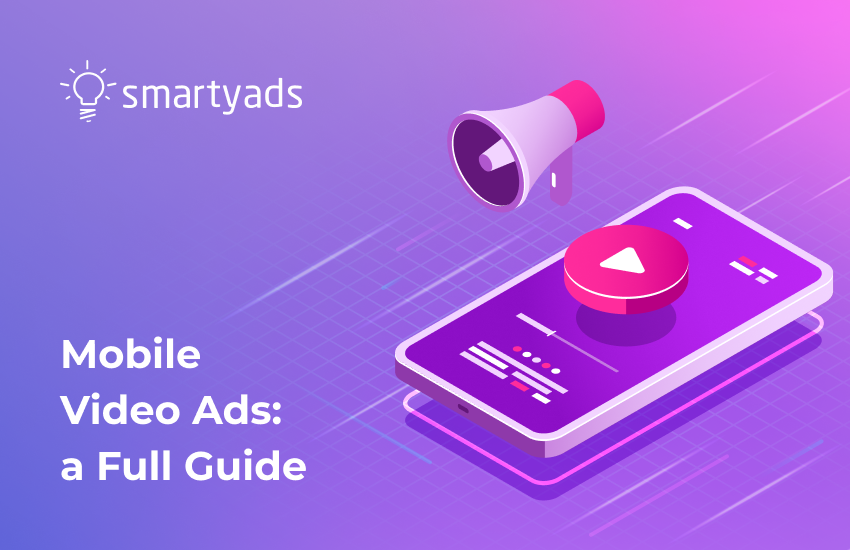In an era dominated by smartphones and a constant thirst for on-demand content, mobile video advertising has emerged as a formidable force in the marketing world. With the ability to captivate audiences in the palm of their hands, businesses are harnessing the power of mobile video ads to engage, entertain, and influence consumers on an unprecedented scale.
Mobile video advertising remains a hot topic of discussion among marketers of all kinds, as this type of advertising hasn't lost its relevance in several years. Mobile video advertising statistics show that the visibility of mobile video ads is over 80%, which is very high, potentially offering significant benefits to brands.
Marketers also see this and understand the benefits offered by mobile video ads. As a consequence, spending on such advertising is growing all the time. According to the latest data, mobile ad spending will be almost $399.6 billion by 2024. It perfectly shows how big a niche mobile advertising has occupied in the advertising strategies of so many companies.
The Covid-19 pandemic has significantly reshaped our daily lives, altering how we work, communicate, and access information. With the restrictions on physical interactions and the need for social distancing, people have increasingly turned to the digital realm to stay connected, informed, and entertained.
As a result, there has been a notable surge in online activity, with a substantial rise in the number of individuals relying exclusively on smartphones to access the Internet. This trend highlights the transformative power of the pandemic in reshaping our relationship with technology and emphasizes the importance of understanding its implications. Because of this, the mobile video advertising world began to develop even more rapidly.
In addition, according to IAB Europe's State of Online Video Advertising in 2022 report, video formats that are expected to generate the most revenue include vertical video ads, rewarded video ads, and interactive video ads. All of these formats are used in mobile video advertising.
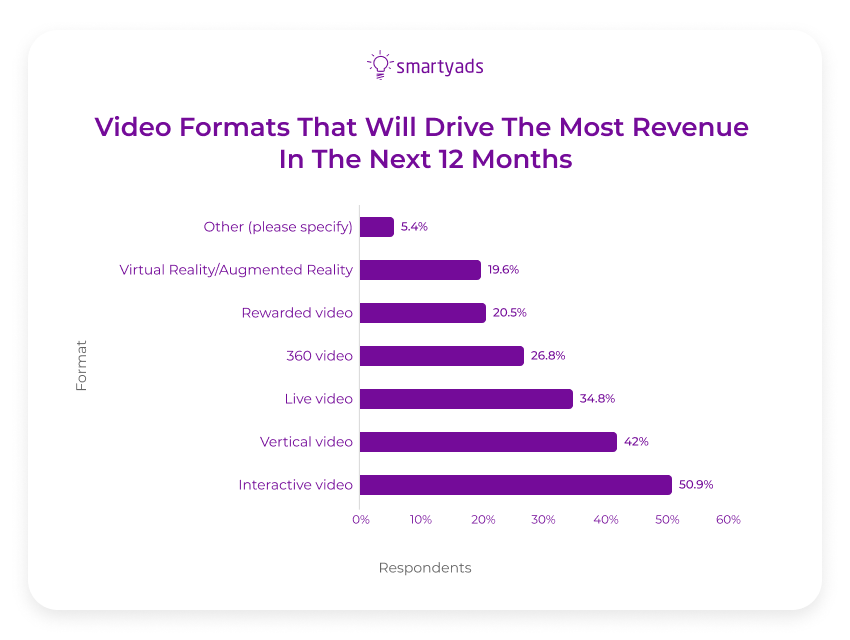
So, we've figured out that mobile video advertising is very relevant and necessary for every brand and marketer associated with it. Can anyone use such advertising? Even a small, newly founded business? Of course, they can. It is exactly why there are programmatic platforms like our SmartyAds DSP with mobile video advertising networks to provide such an opportunity.
But let's get into it one by one. In this article, you'll learn what mobile video advertising is, what it's for, and how to use it to increase conversions.
What is mobile video advertising?
Mobile video advertising refers to dynamic, visual advertisements specifically designed for consumption on mobile devices, including smartphones and tablets. These ads utilize the captivating power of video content to engage and influence users within the mobile ecosystem.
Mobile video advertising can take various forms, such as pre-roll, mid-roll, or post-roll ads, and is strategically placed within mobile apps, websites, or social media platforms. They leverage the popularity of mobile devices and the preference for on-the-go content consumption to deliver immersive, interactive, and personalized experiences, enabling advertisers to effectively communicate their brand message, drive user engagement, and prompt desired actions.
The measurement and analysis of key metrics help advertisers evaluate the performance of mobile video ads, optimize targeting strategies, and enhance campaign effectiveness in reaching and resonating with target audiences in the mobile-first era.
What makes mobile video advertising good?
Mobile phone video advertising offers a compelling advantage — the ability to engage viewers at any time, anywhere. Whether waiting for a bus, standing in line, or enjoying a leisurely coffee break, individuals often turn to their smartphones for quick doses of entertainment. By seamlessly integrating video ads into this on-the-go lifestyle, brands can leverage these moments to capture attention and drive brand awareness.
The explosive growth of social media platforms has further bolstered the rise of mobile video advertising. Facebook, Instagram, TikTok, and YouTube have become virtual playgrounds where businesses can strategically position their video ads to target specific demographics and user interests. These platforms offer a vast audience base, detailed targeting options, and robust analytics, allowing advertisers to fine-tune their campaigns and optimize their reach.
One of the key strengths of mobile video ads is their ability to evoke emotions and tell compelling stories concisely. With limited screen real estate and fleeting attention spans, advertisers must seize viewers' attention within seconds and deliver a captivating message. Clever storytelling, striking visuals, and concise narratives are vital for success in this competitive landscape.
Mobile video ad formats
Mobile video advertising is diverse, taking many forms and presented in many ways. In fact, mobile video advertising has virtually no limitations. The boundary here is where marketers' imagination ends, and their imagination, as everyone knows, is very, very wide.
So let's take a look at mobile video ad formats.
Instream Video Ads
Instream video ads are typically shown before, during, or after video content within mobile apps or websites. These ads can be skippable or non-skippable, often appearing within video players, delivering a seamless viewing experience. Instream ads provide an opportunity to reach a captive audience and can effectively convey brand messages.
More than half of YouTube viewers use mobile devices to watch video content, so this type of advertising is very relevant.
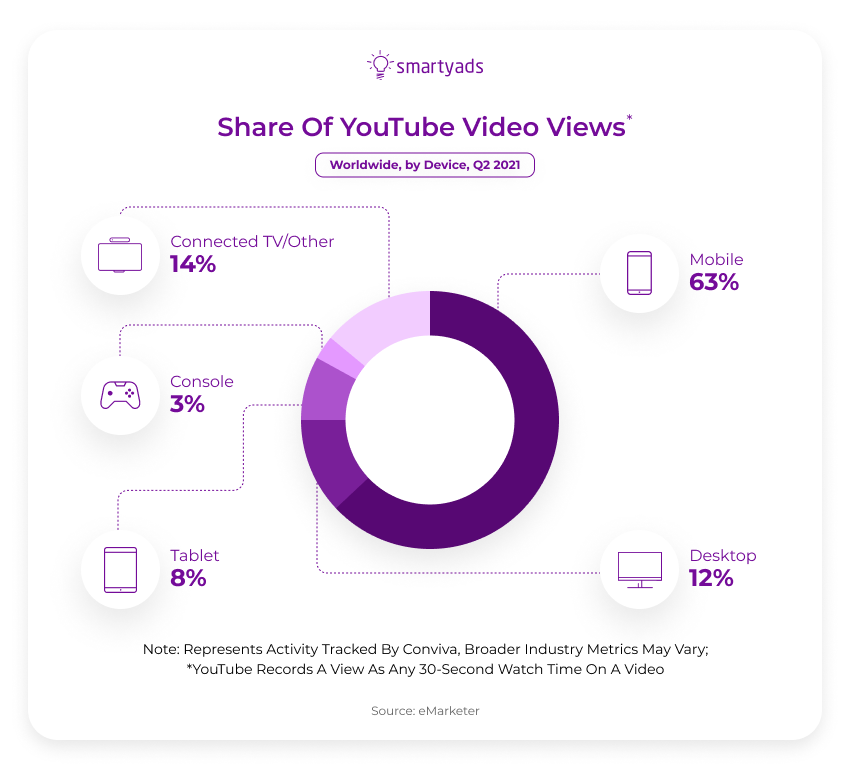
Outstream Video Ads
Outstream video ads, also known as native video ads, are standalone video units that autoplay within content, such as news articles or social media feeds. These ads are displayed without being embedded within video content, making them versatile and enabling placement in various contexts. Outstream ads often have sound-off autoplay, allowing users to engage with the ad by tapping or expanding it for sound and further interaction.
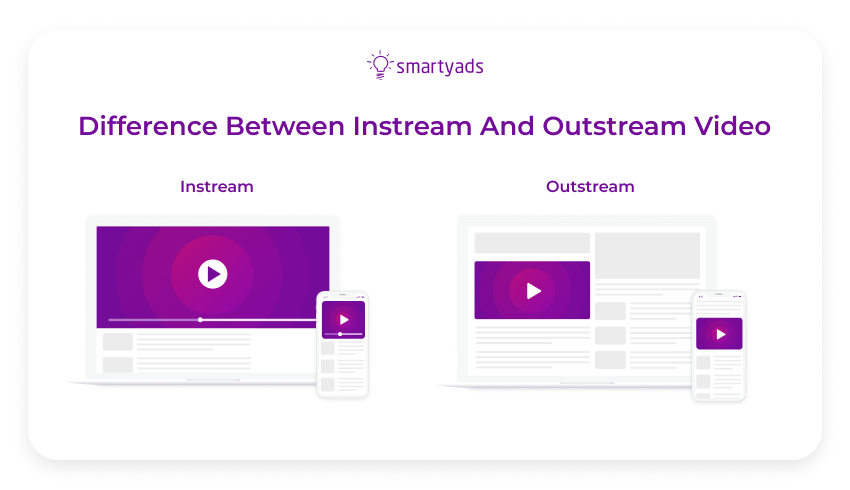
In-App Video Ads
In-app video ads are specifically designed for mobile apps and appear during or between app sessions. In-app video ads can take the form of full-screen interstitials, rewarded videos, or banner ads with video elements. Rewarded videos, in particular, offer users a reward, such as in-app currency or additional content, in exchange for viewing the ad, fostering positive user engagement.
Rewarded Video ads
Rewarded video advertising is a format that gives users a reward in exchange for their time spent viewing the ad. For example, if your mobile game allows you to pay with coins, you can give users a lot of coins if they view the ads for 30 seconds. Rewarded video ads last for 15-30 seconds and cannot be skipped, but users always have the option to disable them.
Social Media Video Ads
Social media platforms like Facebook, Instagram, Twitter, and TikTok provide opportunities for mobile video advertising to reach highly targeted audiences. These platforms offer various ad formats, such as in-feed videos, stories ads, or immersive vertical videos, designed to seamlessly blend with the user experience and encourage interaction through likes, comments, and shares.
Vertical Video Ads
With the popularity of mobile viewing and the predominance of vertical orientation, vertical video ads have gained traction. These ads are specifically created to fit the vertical format of mobile screens, maximizing visibility and providing a seamless viewing experience without users needing to rotate their devices.
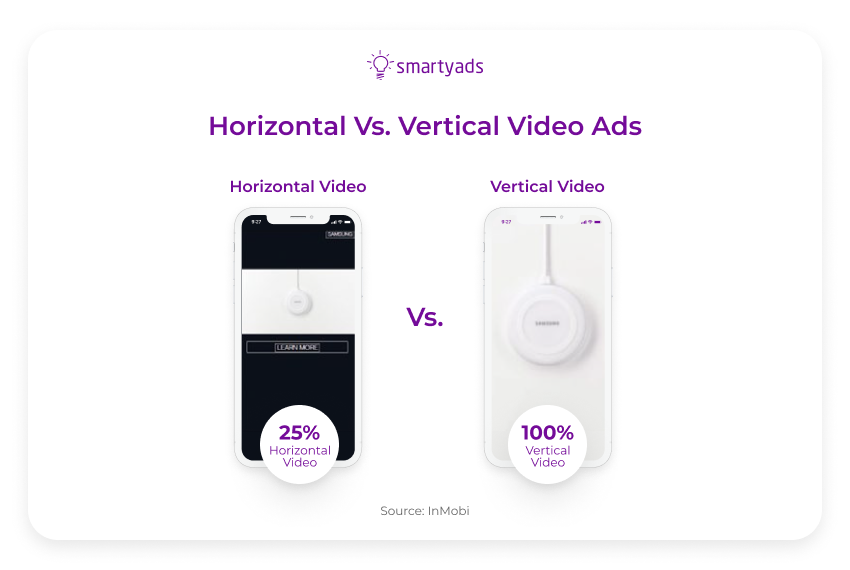
Interactive Video Ads
Interactive video ads offer users the opportunity to engage and interact with the content, going beyond passive viewing. These ads may include elements such as clickable hotspots, polls, quizzes, or mini-games, encouraging users to participate and enhancing user engagement and brand interaction.
Augmented Reality (AR) Ads
AR video ads leverage the capabilities of mobile devices to overlay virtual elements in the real world. These ads can provide users with interactive and immersive experiences, allowing them to visualize products in their environment, check virtual try-ons, or play AR games. AR ads offer a unique and captivating way to showcase products and drive user engagement.
Playable Video Ads
Playable video ads, also known as "try before you install" ads, allow users to interact with a mini version of a mobile game or app before downloading it. Users can experience a snippet of the gameplay, which gives them a taste of the app's features and encourages them to download and engage with the full version.
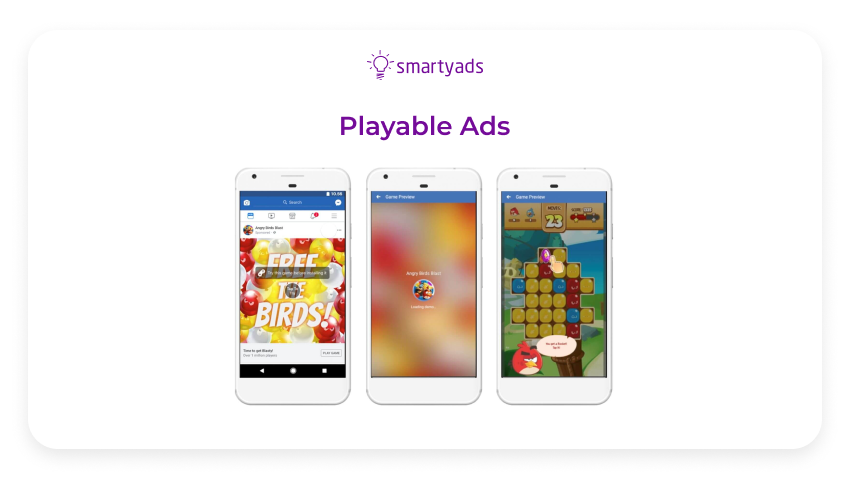
Live Video Ads
Live video ads take advantage of the growing popularity of live streaming on mobile devices. These ads appear within live streams, providing real-time brand exposure to viewers. Advertisers can sponsor live streaming events, collaborate with influencers, or display overlay ads during live broadcasts to reach and engage audiences during their mobile viewing experience.
Interstitial Video Ads
Interstitial video ads are a type of mobile video ad that appears in full-screen format between content transitions. Interstitial video ads are typically displayed during natural pauses or breaks in the user's app or website experience, such as between levels in a game, during app launches, or while a webpage loads. Interstitial video ads offer advertisers a highly impactful and immersive advertising format that captivates users' attention.
Sponsored Filters and Lenses
Sponsored filters and lenses are interactive video ads that overlay augmented reality (AR) effects on a user's face or surroundings in real time. Popularized by platforms like Snapchat and Instagram, these ads allow users to transform their appearance, try virtual makeup, or interact with branded AR elements. Sponsored filters and lenses provide immersive and shareable experiences, increasing brand exposure and user engagement.
360-Degree Video Ads
360-degree video ads enable users to explore an immersive, panoramic environment by dragging or tilting their mobile devices. These ads provide an interactive and engaging experience, allowing users to have a 360-degree view of a location, product, or event. 360-degree video ads can be particularly effective in travel, real estate, or entertainment industries.
Why mobile video ads are effective?
The visual impact of video content cannot be overstated. With the ability to convey messages, emotions, and brand stories in a captivating and memorable way, video ads create a strong connection with viewers. Combining moving images, audio, and compelling narratives allows advertisers to leave a lasting impression, increasing brand awareness and recall among the target audience.
Enhanced user experience
One of the key advantages of mobile video ads is the enhanced user experience they offer. Mobile devices provide a personalized and interactive platform for content consumption. Video ads can be optimized to fit mobile devices' screen sizes and resolutions, ensuring a seamless and immersive viewing experience. This alignment with user preferences and behaviors enhances user engagement, encouraging viewers to interact more with the ad content.
Targeted reach
The targeted reach of mobile video advertising is another crucial factor in their effectiveness. Mobile devices have become a treasure trove of user data, capturing information about demographics, interests, and browsing behavior. Advertisers can leverage this data to precisely target specific audiences with relevant video ads. By reaching the right people at the right time, mobile video ads can effectively drive engagement, conversions, and desired actions, maximizing the return on investment for advertisers.
Flexibility and variety
The flexibility and variety offered by mobile video ads further contribute to their effectiveness. Advertisers can choose from a range of mobile video ad formats, including in-stream, outstream, social media ads, interactive ads, interstitial video ads, and in-app video ads.
This versatility allows campaigns to be tailored to specific platforms, target audiences, and campaign objectives. Adapting video ads to different formats and placements enables advertisers to optimize their impact and reach a wider audience.
Measuring the performance
Measuring the performance of mobile video ads is vital for advertisers to make informed decisions and optimize their campaigns. Robust measurement and analytics capabilities provide valuable insights into key performance metrics, such as view rates, completion rates, click-through rates, and conversions.
Armed with this data-driven approach, advertisers can analyze the effectiveness of their video ad campaigns, make data-backed decisions, and refine their targeting strategies to drive better results.
High CPM and conversion rates
Mobile video ads have gained significant traction in the digital advertising industry due to their outstanding performance, boasting high mobile video ads CPM and conversion rates. Advertisers and publishers alike have been quick to capitalize on this lucrative opportunity, as these ads offer a compelling and profitable avenue for reaching and engaging with target audiences.
Fraud protection
Furthermore, in addition to their impressive results, mobile video ads provide an added advantage of superior fraud protection compared to their desktop counterparts, creating a more secure and trustworthy advertising ecosystem.
Advertisers must be able to use all these advantages competently so that their mobile video advertising efforts are not wasted.
How to create a good mobile video ad?
So, how can you take advantage of the benefits of the video format? What should you do to make your ads interesting, exciting, and yet effective? Let's find out.
Keep it concise. Mobile users have shorter attention spans, so aim for a video ad that is concise and to the point. Keep the duration relatively short, ideally under 30 seconds, to maintain viewer engagement.
Grab attention from the start. The first few seconds are crucial in capturing the viewer's attention. Start your video with a compelling hook or visually striking imagery to immediately grab their interest.
Tell a compelling story. Create video ads that sell. For this, you need to create a narrative that resonates with your target audience. Craft a story that evokes emotion, solves a problem, or showcases the benefits of your product or service. Engage viewers through a captivating storyline that keeps them interested until the end.
Optimize for mobile viewing. Mobile screens are smaller, so optimize your video ad for mobile viewing. Use legible text and clear visuals, and avoid small details that may be hard to see on smaller screens. Ensure your ad looks and performs well across various mobile devices and screen orientations.
Focus on visuals and sound. Visuals play a significant role in mobile video ads. Use eye-catching visuals, vibrant colors, and high-quality imagery to grab attention. Additionally, consider using captions or subtitles, as many viewers watch videos with the sound off. If you include sound, make sure it adds value to the ad and is attention-grabbing.
Strong call-to-action (CTA). End your video ad with a clear and compelling call-to-action. Encourage viewers to take the desired action, such as visiting a website, making a purchase, or downloading an app. Make the CTA prominent and easy to follow.
Test and optimize. Regularly test different variations of your mobile video ad to identify what resonates best with your audience. A/B testing can help you refine elements such as visuals, messaging, duration, and CTAs to optimize performance and maximize engagement.
Consider mobile platform specifications. Different social media platforms and ad networks have specific requirements for mobile video ads. Familiarize yourself with the specifications of the platform you'll be using to ensure your ad meets their guidelines and looks its best.
Conclusions
As mobile usage continues to surge, leveraging the power of mobile video ads can help businesses effectively connect with their target audiences and achieve marketing success in the evolving digital landscape.
To run mobile video ads, try our SmartyAds DSP.
